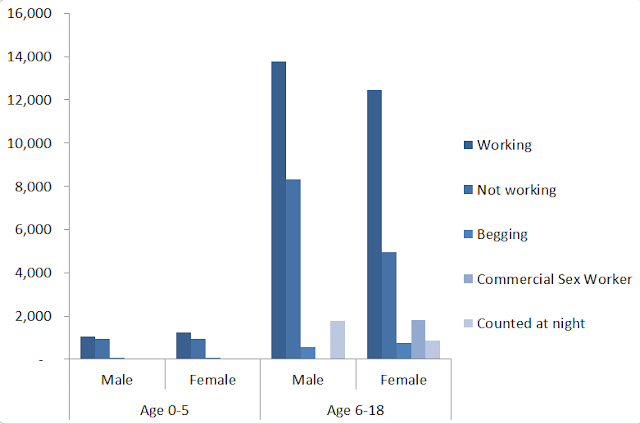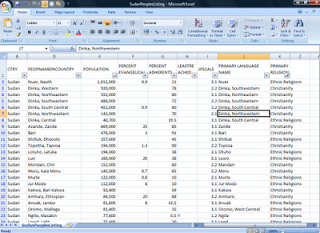- In total there are just under 50,000 kids living and working on the streets in Sierra Leone.
- About half live in Freetown and half in other towns.
- There is a roughly even gender split with slightly more boys than girls.
- These kids make up around 5% of the urban population.
- 4,388 children under 6 years old were counted.
- 2,699 children were found sleeping rough.
- 1,821 under-age girls were recorded as working in the commercial sex industry.
- 633 disabled children were counted.
14 April 2025
Street kids in Sierra Leone
14 October 2024
Census love
"In the absence of actual data (such as an official census), NGO staff make a back-of-envelope estimate in order to plan their projects; a postgraduate visiting the NGO staff tweaks that estimate for his thesis research; a journalist interviews the researcher and includes the estimate in a newspaper article; a UN officer reads the article and copies the estimate into her report; a television station picks up the report and the estimate becomes the headline; NGO staff see the television report and update their original estimate accordingly." (source: www.humanitarian.info) (via Map Kibera Project)I honestly had no idea that Kibera is less than 200,000 people, and not over a million, despite the Kenyan census establishing this fact taking place 2 years ago. Via the Africa Research Institute
31 March 2025
India is really really big
India released its prelim Census estimates today. Lots of blog worthy nuggets -
India's population is about the size of the US, Brazil, Pakistan, Bangladesh, Indonesia and Japan put together.
Its more than the whole of Africa and just UP (my beloved home state) has a greater population than any developing country but China or Indonesia- so much for all the people who say India is over-studied in development or over-invested in aid!!!
The cost of doing a Census is about 40 cents per person. This is somewhere between one-thirtieth and one-fiftieth of the cost in South Sudan. Not saying that the differences in cost of service delivery are always the same magnitude, but guess why it REALLY makes sense to be looking at India.
Lots of changes in demographics - an improving sex ratio, decreasing growth (esp in the most populous states) and a pretty significant jump in literacy with greater gains for women.
I've attached their PDF presentation here. Take a look. very nifty!
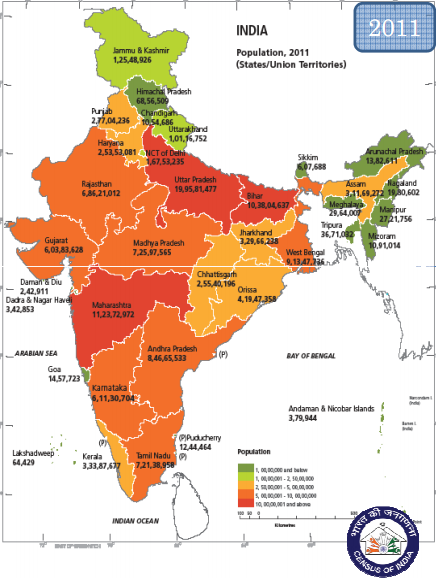
A note on this map - non-Indians should read the numbers with care - the commas are in unusual places due to Crores or Lakhs or some weird thing like that.
25 January 2025
Photo of the Day
Of votes counted so far in the referendum, 98.81% have been for secession. Seems like a good occasion to post this photo of a billboard in Khartoum, taken by a friend during the 2008 Census.
18 June 2025
The Child Labour Market in Juba
This chart comes from a fascinating new report on Child workers in Juba.
Economic Activities of Children working on the streets in Juba.
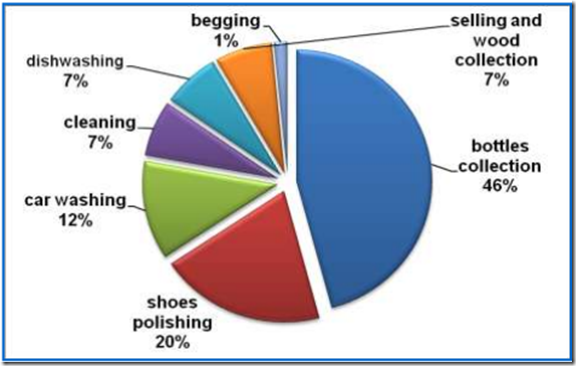
I’m really torn on whether it is a good idea to give money to these kids or not. They are usually around outside the Ministries washing cars, and polishing shoes at the local cafes. It seems like a classic aid problem of weighing the direct benefit vs the indirect harm. Is the meal today worth more than the disincentive to attend school?
I’ve tried to do a bit of homework (er, googling), and one of the foremost experts on the economics of child labour seems to be Kaushik Basu, previously a professor at Princeton and now Chief Economic Adviser to the Government of India (he has written a book on the subject - see here for the review on Marginal Revolution). Sadly though all I can really find are government policy recommendations, with no suggestions for the concerned individual (although there are some general concerns about potentially perverse impacts of well-meaning trade boycotts at the national level.
Any ideas?
Finally back to that report. It doesn’t tell us how many of their interviewees just work on the streets, and how many live there too. It doesn’t tell us how the questions were worded. It doesn’t have any cross-tabulations. Next time I would recommend paying a visit to the SSCCSE for some statistical advice.
17 June 2025
New Poverty figures for Southern Sudan
The Southern Sudan Centre for Census, Statistics, and Evaluation (SSCCSE - yes its a bit of a tongue-twister, but still probably easier to say and remember than the SSFFAMC), released yesterday the results of the first ever nationally representative household survey in Southern Sudan.
The headline to note is that “poverty” is considerably lower than previously estimated. In 2005 somebody licked their finger and stuck it in the air, and decided that probably about 90% of the population was living below a poverty line of $1 a day. This figure then got quoted and repeated in the opening paragraph of every report written since. Back to the drawing-board guys.
The new poverty line (based on a basic calorific intake plus a bit of non-food consumption) is SDG 73 per month - roughly a dollar a day at official market exchange rates (but a bit less at actual unofficial market exchange rates).
50% of the population falls below this poverty line.
Average consumption is SDG 100 per month.
More to come as soon as I can find an online version I can link to.
And does anyone at SSCCSE want to comment?
08 February 2025
On the importance of motivation for results
So the other day I was idly browsing the tinterwebs for some info on the different tribes of Southern Sudan (yes I am that kind of geek). Tribe, ethnicity, language, and religion were all explicitly excluded from the 2006 census and the 2009 household poverty survey because they are too contentious, so I was assuming that hard data is difficult to come across. Not so.
Joshua project is a research initiative seeking to highlight the ethnic people groups of the world with the least followers of Jesus Christ.And oh the data is copious. And detailed. I am slightly creeped out and utterly amazed all at the same time.
15 August 2025
Hut-Count
Marginal Revolution picked up on a clever idea by some economists to measure economic growth in places where statistics are unreliable by looking at satellite images of light at night. If any donors are listening, this could be a great way of looking at the economy in Southern Sudan, where we have very few statistics.
It also got me thinking, couldn't we also measure population by satellite? The Census results have been heavily disputed here for political reasons. Surely an alternative estimate could be gained by just counting the number of buildings on Google Maps and multiplying by an estimate of average household size? Has anyone tried this anywhere before?
06 June 2025
Southern Sudan Census
The Census was actually carried out in 2 halves, the Southern part entirely by the SSCCSE, and the Northern part by the Central Bureau of Statistics (CBS). The Southern part is likely to be more reliable. The Centre has declared that external agencies are free to audit the archives and documentation, and the whole process has been very open. The North on the other hand, has not even shared their raw data with the South.
This is why the main SPLM gripes seem to be with the Northern data - the main issues being the under-counting of the Southerners living in the North, and the over-counting of Darfuris.
The results are available on the website of the Northern Central Bureau of Statistics, and will hopefully be on the SSCCSE site before too long.
01 May 2025
Census
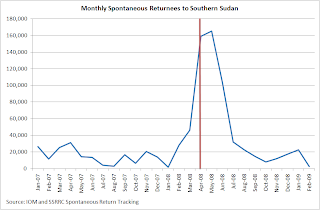
The gross totals are pretty much out but it remains to be seen whether GoSS will accept the results, and whether the detailed data will ever be released. Come on guys, 500,000 people returned to the South for the damn thing. They deserve to know what happened.
(the red line indicates when the Census started)
14 April 2025
Census Speculation
The result of last year's Sudanese census (the first since 1956) is highly political, with a direct bearing upon future power and oil sharing. As a result, negotiations over the numbers have been going on for months.
Kiir has previously vowed not to accept anything less than 15 million for Southern Sudan (about a third of the national population). The latest rumours are putting it at 8.2 million (about a fifth of the national population).
This isn't going to be pretty.
